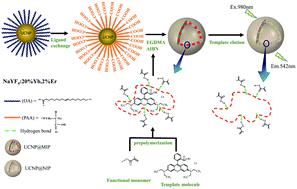当前位置:
X-MOL 学术
›
Dalton Trans.
›
论文详情
Our official English website, www.x-mol.net, welcomes your
feedback! (Note: you will need to create a separate account there.)
Upconversion nanoparticles coated with molecularly imprinted polymers for specific sensing
Dalton Transactions ( IF 3.5 ) Pub Date : 2020-11-03 , DOI: 10.1039/d0dt03555f Ling Yang 1, 2, 3, 4, 5 , Xiaorui Chen 1, 2, 3, 4, 5 , Ping'an Ma 1, 2, 3, 4, 5 , Dayong Jin 6, 7, 8, 9, 10 , Jiajia Zhou 10, 11, 12, 13 , Hao He 6, 7, 8, 9 , Ziyong Cheng 1, 2, 3, 4, 5 , Jun Lin 1, 2, 3, 4, 5
Dalton Transactions ( IF 3.5 ) Pub Date : 2020-11-03 , DOI: 10.1039/d0dt03555f Ling Yang 1, 2, 3, 4, 5 , Xiaorui Chen 1, 2, 3, 4, 5 , Ping'an Ma 1, 2, 3, 4, 5 , Dayong Jin 6, 7, 8, 9, 10 , Jiajia Zhou 10, 11, 12, 13 , Hao He 6, 7, 8, 9 , Ziyong Cheng 1, 2, 3, 4, 5 , Jun Lin 1, 2, 3, 4, 5
Affiliation

|
The development of fluorescent sensors based on lanthanide-doped luminescent nanoparticles has increased their application in biomarker detection. Lanthanide-doped upconversion nanoparticles (UCNPs) have been explored as one of the most promising sensors owing to their merits such as excellent photostability, zero background auto-fluorescence, and reduced side effects of near-infrared triggered treatments. However, traditional upconversion luminescence assay based on direct Fluorescence Resonance Energy Transfer (FRET) between the target molecules and surface of UCNPs encounters low detection accuracy due to superficial adsorption interactions. In this work, we use a molecularly imprinting technique to achieve the specific interaction between UCNPs and molecules for accurate sensing. We demonstrate this by synthesizing a nanostructure with a molecularly imprinted polymer at the surface of UCNPs, in which the imprinted cavities can specifically capture the target molecule of rhodamine B. The upconversion signal changes in relation to the molecule concentration due to FRET. Quantitative analysis shows that the fluorescence-quenching rate is consistent with the Stern–Volmer equation, resulting in a limit of detection of 6.27 μg mL−1. Our fluorescence sensing approach integrates the advantages of both nonlinear upconversion and molecular imprinting technologies, showing great potential for the detection of specific molecules.
中文翻译:

涂有分子印迹聚合物的上转换纳米颗粒用于特定传感
基于掺杂镧系元素的发光纳米粒子的荧光传感器的发展增加了其在生物标志物检测中的应用。镧系元素掺杂的上转换纳米粒子(UCNPs)由于其优异的光稳定性,零背景自发荧光以及减少近红外触发治疗的副作用等优点而被研究为最有前途的传感器之一。然而,由于表面吸附相互作用,基于目标分子和UCNPs表面之间直接荧光共振能量转移(FRET)的传统上转换发光测定法检测精度较低。在这项工作中,我们使用分子印迹技术来实现UCNP和分子之间的特定相互作用,以进行精确感测。我们通过在UCNPs的表面上与分子印迹聚合物合成纳米结构来证明这一点,其中印迹腔可以特异性捕获若丹明B的目标分子。由于FRET,上转换信号与分子浓度有关。定量分析表明,荧光猝灭速率与Stern–Volmer方程相符,检测限为6.27μgmL-1。我们的荧光传感方法融合了非线性上转换和分子印迹技术的优点,显示出检测特定分子的巨大潜力。
更新日期:2020-11-17
中文翻译:

涂有分子印迹聚合物的上转换纳米颗粒用于特定传感
基于掺杂镧系元素的发光纳米粒子的荧光传感器的发展增加了其在生物标志物检测中的应用。镧系元素掺杂的上转换纳米粒子(UCNPs)由于其优异的光稳定性,零背景自发荧光以及减少近红外触发治疗的副作用等优点而被研究为最有前途的传感器之一。然而,由于表面吸附相互作用,基于目标分子和UCNPs表面之间直接荧光共振能量转移(FRET)的传统上转换发光测定法检测精度较低。在这项工作中,我们使用分子印迹技术来实现UCNP和分子之间的特定相互作用,以进行精确感测。我们通过在UCNPs的表面上与分子印迹聚合物合成纳米结构来证明这一点,其中印迹腔可以特异性捕获若丹明B的目标分子。由于FRET,上转换信号与分子浓度有关。定量分析表明,荧光猝灭速率与Stern–Volmer方程相符,检测限为6.27μgmL-1。我们的荧光传感方法融合了非线性上转换和分子印迹技术的优点,显示出检测特定分子的巨大潜力。











































 京公网安备 11010802027423号
京公网安备 11010802027423号